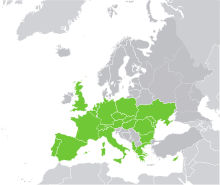Tephritis formosa
| Tephritis formosa | ||||||||||||
|---|---|---|---|---|---|---|---|---|---|---|---|---|

Tephritis formosa |
||||||||||||
| Systematics | ||||||||||||
|
||||||||||||
| Scientific name | ||||||||||||
| Tephritis formosa | ||||||||||||
| ( Loew , 1844) |

Tephritis formosa is a fly from the family of bored flies (Tephritidae).
features
The body length of the drill flies varies from 4–5 mm in the males and 5–6 mm in the females. The head is light beige in color, the thorax beige and the abdomen gray. The legs and antennae are orange-brown. The compound eyes shimmer green or brown. The wings show a species-specific dark brown speckled pattern. The basal third of the wing is largely clear. There is a small brown spot at the ends of the veins R4 and R5.
distribution
The distribution area of Tephritis formosa extends from the Mediterranean area in the south to England, Benelux , Germany and Poland in the north. The species is represented on numerous Mediterranean islands, including the Balearic Islands , Corsica , Sardinia , Sicily , Malta and Crete . In the east, the distribution area extends to the Ukraine, the Balkan Peninsula and Asia Minor to the Caucasus and the Near and Middle East .
Way of life
The bored fly species mainly uses goose thistles ( Sonchus ) as host plants , including the field goose thistle ( Sonchus arvensis ), the rough goose thistle ( Sonchus asper ), the vegetable goose thistle ( Sonchus oleraceus ) and the swamp goose thistle ( Sonchus palustris ). Other less frequently used host plants are the small-headed pippau ( Crepis capillaris ) and the common pigweed ( Hypochaeris radicata ). The larvae develop in the flower heads of their host plants and produce an inconspicuous plant gall . The bored flies can be seen from May to September.
Individual evidence
- ↑ a b c Tephritis formosa in Fauna Europaea. Retrieved July 9, 2020
- ↑ a b c Tephritis formosa . bladmineerders.nl. Retrieved July 9, 2020.
Web links
- Tephritis formosa at www.naturespot.org.uk
- Tephritis formosa at naturspaziergang.de
- Tephritis formosa at aramel.free.fr
